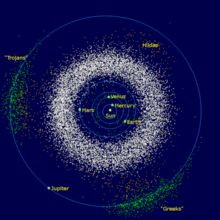3000 Leonardo
| Discovery | |
|---|---|
| 13.60[10][12] 13.70[1][3][13][14] 13.80[5] | |
3000 Leonardo, provisional designation 1981 EG19, is a carbonaceous background
Orbit and classification

Leonardo is a non-
In 1986, 3000 Leonardo was observed to be at its predicted location.[15] It was one of 450 minor planets whose location was checked in a large observation campaign involving multiple sites and astronomers.[15] 3000 Leonard was visually observed by Roger E. Harvey on August 30, 1986 with a 73 cm Newtonian telescope from eastern North America (Concord, North Carolina in the United States).[15][16]
Name
This
- Ceres
- 2000 Herschel for William Herschel who discovered Uranus
- 3000 Leonardo for Leonardo da Vinci
- 4000 Hipparchus for ancient Greek astronomer Hipparchus
The sequence continues with the asteroids
By 2001, 3000 Leonardo was one of 32 named minor planets named after painters and sculptors, and some other examples in this category include
At the time of 3000 Leonardo's discovery and naming only a few thousand asteroids had been discovered and named, it would not be until the 1990s and early 2000s when there was a massive spike in asteroid discoveries, with the peak year up to the year 2010, being 2000.[22] In the year 2000, over 40,000 minor planets were recorded, and in the years after many tens of thousands were discovered leading to almost 220,000 numbered minor planets by late 2009.[22]
Physical characteristics
Leonardo was one of 1341 main-belt asteroids observed between 1993 and 1999 as part of
Rotation period
In October 2015, a rotational
Diameter and albedo
According to the survey carried out by the
The Collaborative Asteroid Lightcurve Link assumes a standard albedo for a stony asteroid of 0.20 (rather than for a carbonaceous one) and consequently calculates a shorter diameter of 5.41 kilometers based on an absolute magnitude of 13.7.[13]
See also
- 30000 Camenzind (minor planet number thirty thousand)
References
- ^ a b c d e "3000 Leonardo (1981 EG19)". Minor Planet Center. Retrieved 30 October 2018.
- ^ ISBN 978-3-540-00238-3.
- ^ a b c d e f "JPL Small-Body Database Browser: 3000 Leonardo (1981 EG19)" (2018-09-06 last obs.). Jet Propulsion Laboratory. Retrieved 30 October 2018.
- ^ a b "Asteroid (3000) Leonardo". AstDyS-2, Asteroids – Dynamic Site. Retrieved 1 June 2019.
- ^ S2CID 45334910.
- ^ S2CID 119289027.
- ^ Bibcode:2016PDSS..247.....M. Retrieved 30 October 2018.
- ^ S2CID 118745497.
- ^ )
- ^ hdl:11336/63614.
- ^ ISSN 1052-8091.
- ^ S2CID 119214002.
- ^ a b c d e "LCDB Data for (3000) Leonardo". Asteroid Lightcurve Database (LCDB). Retrieved 30 October 2018.
- ^ S2CID 9341381.
- ^ a b c "1987MPBu...14...23P Page 24". adsbit.harvard.edu. Retrieved 30 October 2018.
- ^ "1987MPBu...14...23P Page 28". adsbit.harvard.edu. Retrieved 30 October 2018.
- ^ "MPC/MPO/MPS Archive". Minor Planet Center. Retrieved 30 October 2018.
- ^ ISBN 9781438131863. Retrieved 30 October 2018.
- ^ ISBN 9781560989820.
- ^ "Trek On, Spock: Asteroid Now Carries Leonard Nimoy's Name". Space.com. Retrieved 1 November 2018.
- ^ "How Are Minor Planets Named?".
- ^ ISBN 9781438131863.
- ^ "SMALL MAIN-BELT ASTEROID SPECTROSCOPIC SURVEY, PHASE II - Data.gov". catalog.data.gov. Retrieved 28 October 2018.
- ISSN 1052-8091.
External links
- Asteroid 3000 Leonardo, Small Bodies Data Ferret
- Dictionary of Minor Planet Names, Google books
- Discovery Circumstances: Numbered Minor Planets (1)-(5000) – Minor Planet Center
- 3000 Leonardo at AstDyS-2, Asteroids—Dynamic Site
- 3000 Leonardo at the JPL Small-Body Database
